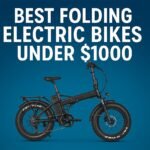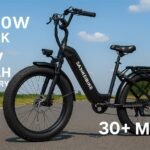Enjoy your ride, every day counts!
![Best Folding Electric Bikes Under $1000: 5 Winners Ranked for [year] Budget Folding E-Bikes Under $1000: 52V Power, 20Ah Range Picks](https://goebikelife.com/wp-content/uploads/2025/10/Best-Folding-Electric-Bikes-Under-1000.jpg)
If you’ve been eyeing a folding e-bike that’s portable, punchy, and doesn’t wreck your budget, you’re in the right place. Below, I’ll break down the five best folding electric bikes you can realistically buy for under $1,000—then give you a plain-English checklist so you know exactly what to look for (and what corners brands cut at this price).
Shortlist (quick verdicts):
- Best Overall: Jasion X-Hunter — balanced power, comfort, and real-world value under $1k.
- Best Range Per Dollar: EUYBIKE F7T — 48V 20Ah battery and claimed 80-mile PAS range at sale prices that routinely dip below $1k.
- Best Power (52V system) Under $1k: Sasikeibike E7 — 52V 20Ah battery, 30+ mph claims, dual suspension; regularly advertised at $799–$849.
- Best “UL-Mentioned” Bargain: Cybervelo EK4 — brand lists UL2849 compliance and frequent sale pricing in the $699–$999 window.
- Best Lightweight Feel & Easy Fit: Aipas F3 — narrower 20″×3.0″ tires, full suspension, 28 mph claim, and handy proportions for smaller storage spaces.
Pricing on Amazon/brand stores fluctuates with coupons and flash sales. I’ve prioritized models that commonly sit below $1,000 at checkout.
What to Expect for < $1,000 (and what you won’t get)
You can get:
- 750–1,000W nominal hubs (many advertise “peaks” to 1,400–1,500W).
- 48V systems (occasionally 52V at this price), 13–20Ah batteries (≈624–960Wh).
- 20-inch fat tires (3.0″–4.0″) and mechanical disc brakes.
- Front or dual suspension, a basic LCD, and class-2/3 speeds (20–28+ mph, brand-claimed).
- Folding hinges adequate for daily commuting (but still heavy to lug upstairs).
You usually won’t get:
- Brand-name cells with official documentation, high-end hydraulic brakes, fancy torque sensors (most use cadence), or sub-60-lb weights (most fold, yet weigh ~65–75 lb).
How to Choose (10-Point Checklist)
- Battery (Wh): Multiply V × Ah. Example: 48V × 20Ah ≈ 960Wh—strong for this price.
- Motor & Controller: 750W nominal is the real baseline; peaks are marketing-friendly but still useful for hills and starts.
- Gearing & Cadence: 7-speed is standard; cadence sensors are fine for cruising, just expect an “on/off” feel vs. a natural torque sensor.
- Tires: 20″×4.0″ feel cushy; 20″×3.0″ save a bit of weight and roll quicker on pavement.
- Suspension: Front is common; rear shocks add comfort but can squeak or need occasional tightening on budget frames.
- Brakes: Mechanical discs are the norm; check rotor size (160–180 mm).
- Weight & Folded Size: Most of these are 65–75 lb—okay for car trunks, not ideal for daily stair carries.
- UL Claims: If you live where fire safety codes matter (e.g., NYC), look for UL 2849 (system) and/or UL 2271 (battery) listings clearly stated by the brand.
- Warranty & Parts: A year on motor/battery is common; verify how/where service is handled.
- Use Case Fit: Commute? Weekend rides? Apartment storage? Pick tire width and suspension based on how you actually ride.
Comparison Table (at a glance)
| Model | System | Battery | Claimed Top Speed | Claimed Max Range | Tires | Suspension | Claimed Weight / Fold Size | UL Mention |
|---|---|---|---|---|---|---|---|---|
| Jasion X-Hunter | 48V (85 Nm torque claim) | 48V 13Ah | up to ~30 mph (brand) | not highlighted as a single figure; PAS levels listed | 20″×4.0″ | Full | 71.2 lb; Folded 38.5″×17.7″×27.1″ | Not stated |
| EUYBIKE F7T | 48V | 48V 20Ah | 30 mph (brand) | 80 miles PAS / 40 miles throttle | 20″ fat | Front | “Only 65 lb”; fold spec shown | “UL Certified” mentioned |
| Sasikeibike E7 | 52V | 52V 20Ah | 30+ mph (brand) | 50–70 miles PAS | 20″×4.0″ | Dual | ~70 lb; Folded 37″×20″×26″ | “UL Certified” mentioned |
| Cybervelo EK4 | 48V | 48V 20.8Ah | 25+ to 30 mph (brand) | 80+ miles (brand) | 20″ fat | Front | 330-lb payload (page) | Brand claims UL2849 |
| Aipas F3 | 48V | 48V 12.8Ah | 28 mph (brand) | 62 miles (brand) | 20″×3.0″ | Full | Folding form factor; commuter-friendly | Not stated |
Specs are summarized from each brand’s product page as of October 2025.
The Winners (Deep Dives)
1) Jasion X-Hunter — Best Overall Under $1,000
If you want a folding fat-tire e-MTB style ride that still feels like a commuter, the X-Hunter hits the sweet spot. Jasion lists a 48V 13Ah pack, 85 Nm torque, multi-mode PAS with speed caps per level (PAS 1 ≈ 12 mph up to PAS 5 ≈ 28+ mph), and a folded size of 38.5″×17.7″×27.1″. The page also notes a 71.2-lb net bike weight—solid for a dual-suspension folder with 4.0″ rubber.
Why it stands out:
- Well-rounded tuning for commuting and weekend dirt paths.
- Transparent PAS speed mapping and torque claim (nice for new riders learning pacing).
- Aggressively discounted $899 sale price on the brand site at the time of writing (often with rack/fender bundles).
Where it compromises:
- 13Ah battery is fine, but not road-trip huge; daily commuters may still want to top off mid-week.
- Mechanical discs and cadence sensing are perfectly serviceable, just not premium.
Buy if: you want a confident first folding e-bike with honest-feeling assistance and an easy upgrade path down the road (tires, seat, lights). Skip if you specifically need a 52V / 20Ah long-range rig.
2) EUYBIKE F7T — Best Range Per Dollar
EUY’s F7T touts a 48V 20Ah battery (≈960Wh), 30 mph top speed claim, and up to 80 miles on pedal assist (≈40 miles throttle only). The product text also mentions a UL certification claim and highlights a relatively approachable ~65-lb weight for a fat-tire folder.
Why it stands out:
- Big battery for sub-$1k—ideal for riders with longer commutes or weekend adventure loops.
- UL claim is a plus for safety-minded shoppers (if you need documentation for your building/municipality, ask the seller for the listing file/number).
Where it compromises:
- Heavier than a skinny-tire folder; still fine in car trunks but not fun on stairs.
- Components are commuter-grade; don’t expect hydraulic brakes.
Buy if: you want maximum range on a tight budget. Skip if you’re weight-sensitive or climbing stairs daily.
3) Sasikeibike E7 — Best Power (52V) Under $1,000
When you spot 52V at this price, your ears should perk up. E7 lists a 52V 20Ah pack, 750W hub (1500W peak), 30+ mph top speed claim, dual suspension, 20″×4.0″ tires, and a folded 37″×20″×26″ footprint—with UL Certified called out on-page. Sale prices of $799–$849 are common on the brand storefront.
Why it stands out:
- 52V system tends to feel more eager off the line than otherwise similar 48V folders.
- Dual suspension + 4.0″ tires equals very forgiving ride quality on broken pavement.
Where it compromises:
- The brand is smaller; treat range/speed claims as optimistic and cross-check reviews.
- ~70 lb with battery isn’t shoulder-friendly.
Buy if: you crave a zippier 52V feel and value comfort. Skip if your storage space absolutely demands the lightest folder you can find.
4) Cybervelo EK4 — Best “UL-Mentioned” Bargain
The EK4 listing calls out 48V 20.8Ah battery capacity, 1000W (1500W peak) motor, 25+ mph top speed, ~80+ mile range, and front suspension with dual disc brakes. Cybervelo’s site also highlights UL 2849 compliance and routinely shows sale pricing around $699–$999 for EK4 variants.
Why it stands out:
- UL2849 mention on the brand site—a noteworthy signal for buyers in stricter municipalities.
- Big battery for the money.
Where it compromises:
- Spec language can vary a bit between marketplace listing and brand site; take “80+ miles” as best-case PAS on flat ground.
- Component spec (brakes, contact points) is budget-standard.
Buy if: you prioritize a UL-mentioned option with stout battery size on a tight budget. Skip if you want dual suspension or a 52V system.
5) Aipas F3 — Best Lightweight Feel & Easy Fit
The F3 plays a smarter portability game with 20″×3.0″ tires, full suspension, and a 48V 12.8Ah battery paired to a 1,500W peak motor. Aipas claims 28 mph top speed and up to 62 miles max range, which is realistic-ish for PAS level 1 on flatter routes.
Why it stands out:
- 3.0″ tires roll quicker and cut a little weight/bulk compared with 4.0″ fat tires.
- Full suspension helps tame curb cuts and gravel shortcuts on urban routes.
Where it compromises:
- The 12.8Ah pack is the smallest here; fine for moderate daily commutes, but not a range champ.
- UL isn’t stated on the listing page.
Buy if: your trunk space or apartment closet says “no” to huge 4.0″ rubber—but you still want comfort. Skip if you need long-range autonomy.
Real-World Range (how to estimate yours)
Brand ranges are optimistic because they’re measured with a light rider, eco PAS, smooth pavement, mild weather, and little stopping. For reality checks:
- Throttle only: Expect ~50–60% of the PAS claim in the real world.
- PAS 2–3 commuting (mixed stops, 160–200 lb rider): Expect ~60–75% of the PAS claim.
- Hills/wind/cold: Cut another 10–25% depending on severity.
Quick math:
- 48V×13Ah ≈ 624Wh. If you average 15 Wh/mi (a fair city target), that’s ≈ 41 miles PAS.
- 48V×20Ah ≈ 960Wh at 15 Wh/mi → 64 miles PAS; at a peppy 20 Wh/mi → 48 miles.
Safety & Compliance (What UL 2849/2271 actually mean)
- UL 2849 covers the system (battery, charger, motor controller working together).
- UL 2271 covers the battery pack.
Some brands call out “UL Certified” on their product detail pages (EUY F7T, Sasikeibike E7), and Cybervelo’s site explicitly references UL 2849. If you need documentation for your landlord or local code enforcement, ask for the listing number and issuing lab before you buy.
The “Under $1,000” Reality Check (Where the money goes)
- Battery cells: Larger packs (20Ah) are the priciest line item. Brands keep costs down with generic cells; treat ranges as best case.
- Brakes: Mechanical discs are standard; they work—but expect more lever throw and occasional cable stretch vs. hydraulics.
- Suspension: Basic spring shocks get the job done. Check bolts after the first 50–100 miles.
- Wheels & tires: 4.0″ fat tires add weight/drag; they’re comfy and confident on bad pavement. 3.0″ rides feel quicker and easier to carry.
- Service: Direct-to-consumer (DTC) brands keep prices low by shipping 85–95% assembled. If you’re not handy, budget a local shop setup.
Who Should Buy a Folding Fat-Tire E-Bike?
Choose this style if you need:
- Trunk portability and urban storage flexibility (closets, offices).
- Confidence on potholes, gravel, light trails.
- Commuter-plus use: weekday rides to work and weekend play.
Consider a slimmer 700c/27.5″ commuter or mini-folder if you:
- Carry your bike up stairs daily.
- Ride mostly smooth bike lanes and want to keep effort/power use low.
- Need a bike under 55–60 lb (uncommon at this price with suspension).
Setup Tips (first 60 minutes)
- Torque the hinge hardware after your first week; folding bikes loosen faster.
- Brake bed-in: 10–20 firm stops from ~15 mph to “almost stop,” repeated twice.
- Tire pressure: Start 20–25 psi on 4.0″ tires (higher on smoother roads for speed), 28–32 psi for 3.0″ city use.
- Spoke check: Squeeze adjacent spokes—retension if any feel slack.
- Update/verify display limits: ensure your PAS levels and speed settings are within local class rules.
Accessory Must-Haves (that actually help)
- Fold-safe pedals: Metal bodies with positive detents.
- Rear rack & bungees for groceries/gym bags.
- Helmet w/ rear light and bar-end mirror; budget bikes rarely ship with great visibility.
- Armor against flats: Quality tire liners or tubeless conversion on high-puncture routes.
- Second charger at the office if you ride daily (especially sub-15Ah packs).
FAQs
Q: Can these bikes really hit 28–30 mph?
A: On PAS 4–5 with a healthy battery and flat ground, it’s possible (brand claims: X-Hunter, EUY F7T, Sasikeibike E7, Aipas F3; Cybervelo often lists 25+ to 30 mph). Wind, rider weight, and hill grade will pull that down.
Q: How “portable” are they?
A: They fold fast and fit most trunks, but most weigh ~65–75 lb. If you’re carrying up stairs daily, consider a narrow-tire mini-folder or plan to use an elevator. (X-Hunter lists 71.2 lb; EUY F7T mentions “only 65 lb.”)
Q: Which one is best for hills?
A: Look for 52V or a big 48V 20Ah pack plus a controller that can deliver current. From this list: Sasikeibike E7 (52V) and EUY F7T (48V 20Ah) are strong picks.
Q: Which is best for small apartments?
A: Aipas F3 (20×3.0 tires) and the X-Hunter (smaller folded footprint listed) are easier to live with in tight spaces.
Model-by-Model Spec Notes
- Jasion X-Hunter — 48V 13Ah, 85 Nm torque (brand-claimed), PAS speed caps (~12/16/20/24/28+ mph), folded size 38.5″×17.7″×27.1″, net weight 71.2 lb; sale prices often around $899.
- EUYBIKE F7T — 48V 20Ah, up to 30 mph, about 40 miles throttle / 80 miles PAS (brand-claimed), approximate 65-lb weight; sale prices frequently dip under $1,000.
- Sasikeibike E7 — 52V 20Ah, 750W (1500W peak), 30+ mph, 40–50 mi throttle / 50–70 mi PAS, dual suspension, folded 37″×20″×26″; recurring sales ~$799–$849.
- Cybervelo EK4 — 1000W (1500W peak), 48V 20.8Ah, 25+ mph and 80+ miles (brand-claimed); brand references UL 2849 and shows sale pricing in the $699–$999 range.
- Aipas F3 — 48V 12.8Ah, 1,500W peak, 28 mph, up to 62 miles (brand-claimed), full suspension, 20×3.0 tires.
All specifications are brand-reported and may vary with rider weight, terrain, temperature, and settings. Pricing and availability change frequently; always verify on the product page before purchasing.
Final Picks (decisive recommendations)
- One-bike answer for most riders: Jasion X-Hunter — the fewest compromises, the most “daily-friendly” tuning under $1k.
- Need range & value above all: EUYBIKE F7T — big 20Ah battery and frequent sub-$1k sale pricing.
- Want snappier 52V feel: Sasikeibike E7 — 52V system plus dual suspension, strong value.
- Care about UL mention + price: Cybervelo EK4 — brand calls out UL2849 and often prices aggressively.
- Tighter storage / quicker roll: Aipas F3 — 3.0″ tires, full suspension, easygoing commuter manners.





